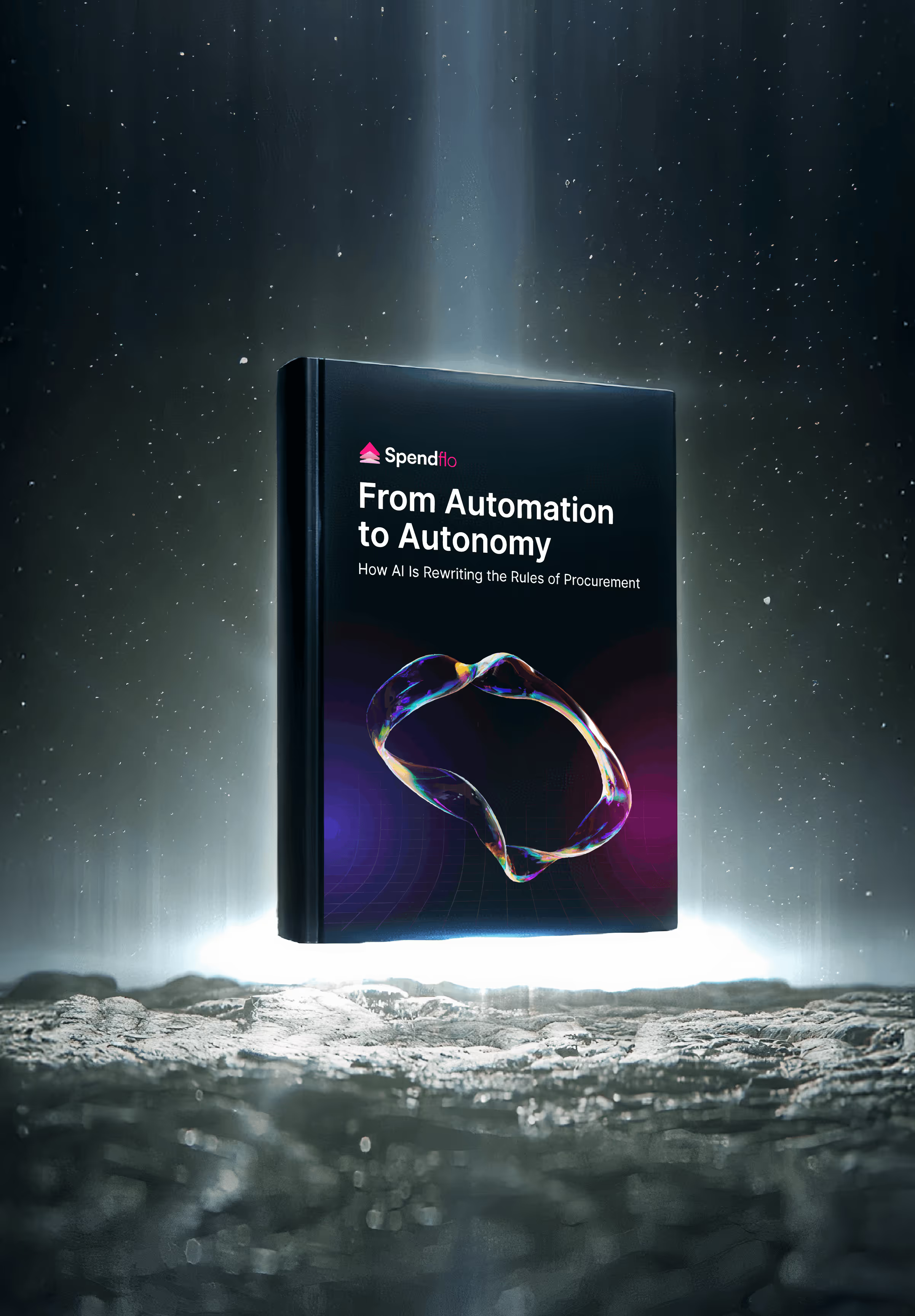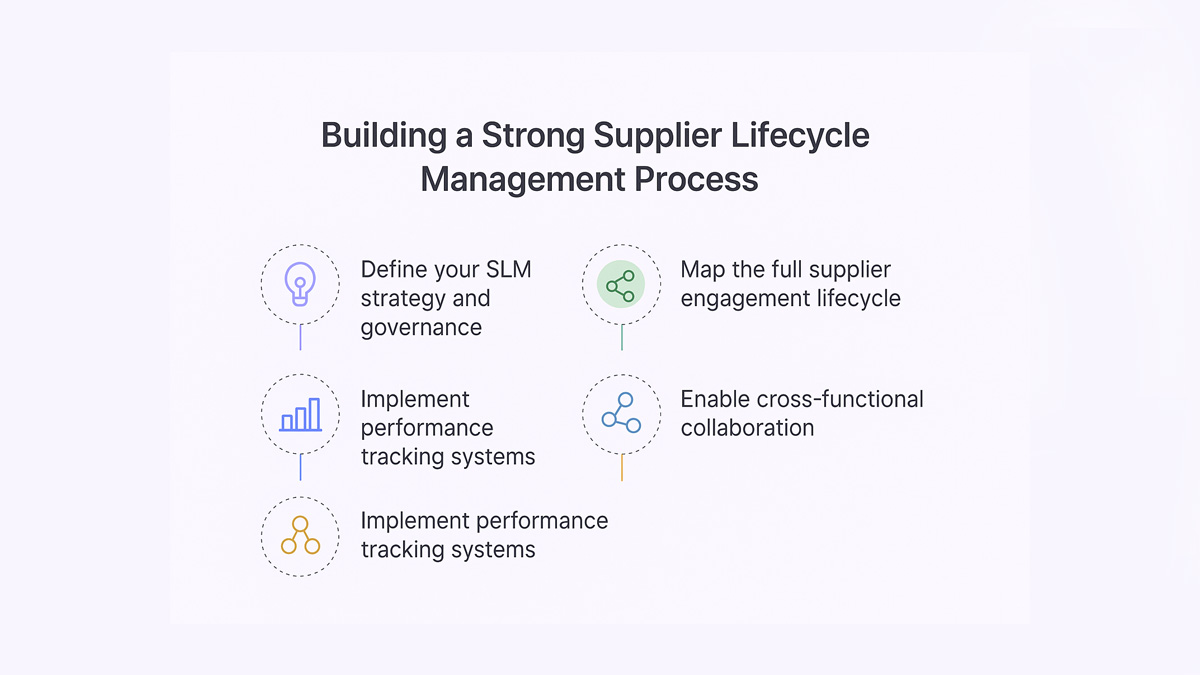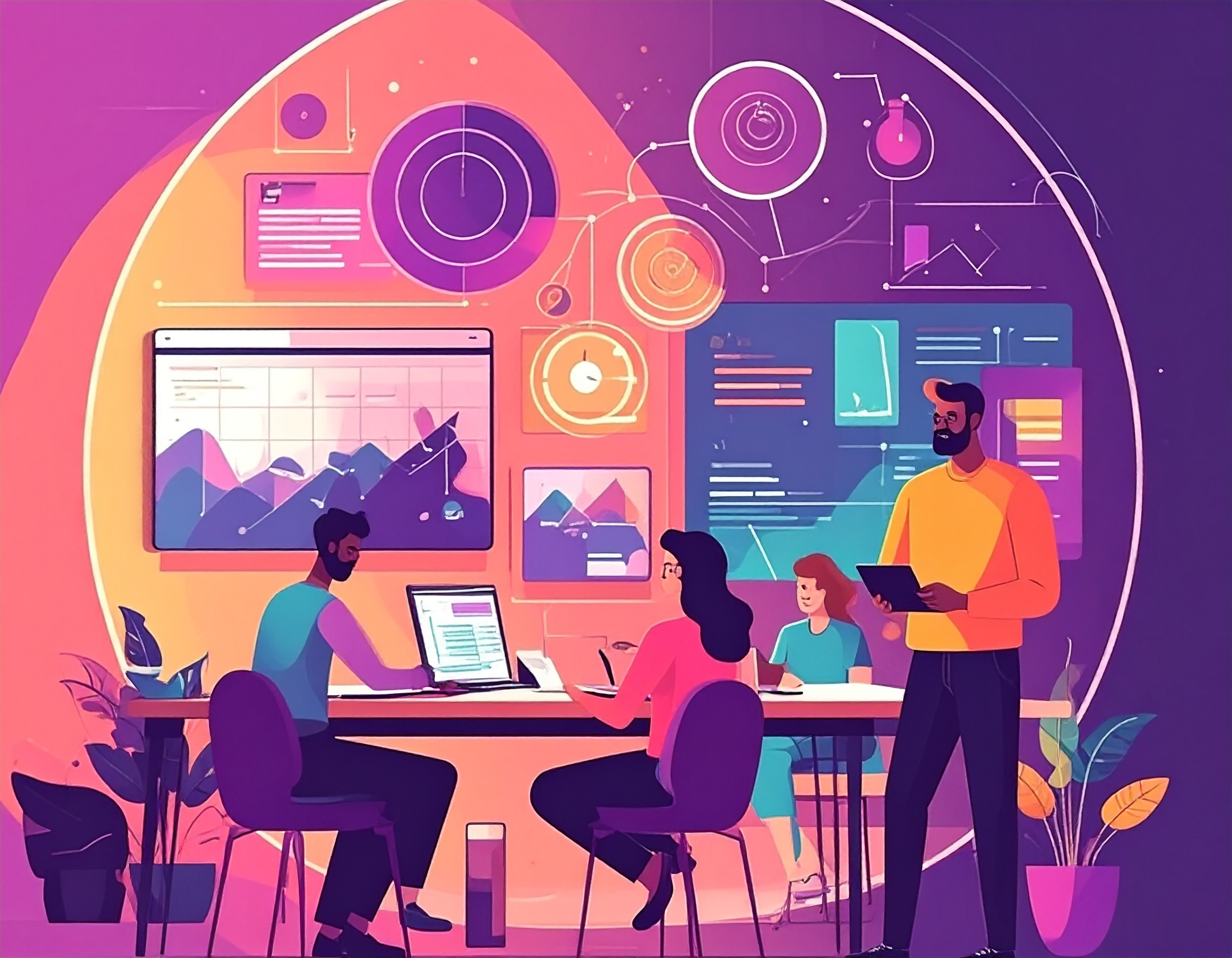

Supplier Lifecycle Management Explained

Supplier Lifecycle Management Explained
Explore the 8 stages of supplier lifecycle management and how SLM drives performance, risk reduction, and smarter procurement strategies.


Think about how much time and effort goes into building a relationship - whether it's with a friend, a customer, or a vendor. You don’t just meet once and call it a day. There’s a process: introductions, expectations, performance checks, sometimes even a goodbye. The same goes for working with suppliers.
Supplier Lifecycle Management (SLM) is that relationship roadmap. It’s how businesses find, evaluate, work with, and - when necessary - part ways with suppliers. Done well, it leads to stronger partnerships, better pricing, reduced risk, and way fewer surprises in the procurement process.
In today’s fast-moving procurement landscape, managing the supplier lifecycle isn’t just nice to have - it’s essential.
What this blog will cover:
- What is supplier lifecycle management?
- The 8 stages of supplier lifecycle management
- Why supplier lifecycle management is crucial in 2025
- How to build a robust supplier lifecycle management process
- Supplier lifecycle management vs traditional supplier management
- How Spendflo helps with supplier lifecycle management
- Frequently asked questions on supplier lifecycle management
What Is Supplier Lifecycle Management?
Supplier Lifecycle Management (SLM) is the end-to-end process of identifying, onboarding, managing, and eventually offboarding suppliers. It ensures every supplier relationship is strategic, compliant, and performance-driven - from initial discovery to final contract closure or termination.
The 8 Stages of Supplier Lifecycle Management
Every supplier journey follows a path - from first contact to contract closure. Understanding each stage of the supplier lifecycle not only helps organizations manage vendors more effectively but also uncovers opportunities for savings, risk reduction, and stronger collaboration. Here's a breakdown of the eight key stages of Supplier Lifecycle Management(SLM), why each matters, and what to focus on at every step.
1. Identification and Supplier Discovery
Every supplier journey begins with knowing where to look. This stage is all about scanning the market for potential partners that meet your operational, ethical, and strategic needs. It lays the groundwork for everything that follows.
Why it’s important: Sets the foundation for quality and strategic sourcing.
Key highlights:
- Analyze business needs
- Research qualified vendors
- Use supplier directories or databases
- Leverage referrals and sourcing platforms
- Evaluate industry certifications
2. Qualification and Selection
Not all suppliers are created equal - this stage filters the good from the great. It's where you assess financial stability, compliance readiness, and operational capability. Supplier Selection at this stage determines long-term procurement success. The goal is to ensure you're starting strong with the right partners.
Why it’s important: Prevents poor-fit vendors from entering the procurement process.
Key highlights:
- Assess capacity and scalability
- Check financial and legal records
- Verify certifications and compliance
- Evaluate service history and reputation
- Conduct initial risk assessment
3. Onboarding and Integration
Once a supplier is selected, onboarding ensures both sides are aligned and ready. From documentation to systems access, this phase sets expectations and builds the foundation for smooth operations. It's the true kickoff of the working relationship. Streamlined Supplier Onboarding reduces delays and prevents early-stage errors.
Why it’s important: Ensures readiness for seamless collaboration and transactions.
Key highlights:
- Collect and verify onboarding documents
- Map responsibilities and SLAs
- Set up in ERP or procurement systems
- Define communication channels
- Align on policies and reporting
4. Performance Tracking and Assessment
After onboarding, the focus shifts to accountability. Tracking performance helps you stay on top of quality, timelines, and service commitments. Align performance metrics with business goals for better results. Without it, even the best vendors can drift off-course. This lays the groundwork for consistent performance management throughout the supplier engagement.
Why it’s important: Maintains accountability and flags issues early.
Key highlights:
- Monitor agreed KPIs
- Use real-time dashboards
- Schedule regular review meetings
- Document performance issues
- Provide feedback loops
5. Collaboration and Continuous Improvement
A strong supplier relationship goes beyond transactions. This stage encourages innovation, transparency, and working together to grow stronger over time. Strong Supplier Relationship Management practices turn vendors into long-term partners. It’s where good partnerships become great.
Why it’s important: Builds long-term, value-driven relationships.
Key highlights:
- Share forecasts and planning data
- Collaborate on product or process innovation
- Create joint cost-saving initiatives
- Align on ESG or compliance goals
- Track shared improvement metrics
6. Contract Administration and Renewal
Managing contracts isn’t just about filing paperwork. It’s about staying proactive on renewals, renegotiations, and performance benchmarks. A solid contract phase protects value and prevents surprises.
Why it’s important: Ensures both parties honor terms and value is maintained.
Key highlights:
- Maintain centralized contract records
- Track renewal timelines
- Benchmark pricing before renewal
- Negotiate changes based on performance
- Align on new scope or deliverables
7. Risk Mitigation and Issue Resolution
No matter how well things are planned, issues happen. This stage is where businesses actively track risks and have protocols in place to act fast. Quick response protects operations and reputation.
Why it’s important: Protects business continuity and reduces legal exposure.
Key highlights:
- Monitor supplier risk factors
- Set escalation protocols
- Define contingency plans
- Audit supplier compliance
- Resolve disputes quickly
8. Offboarding and Termination
Every relationship eventually comes to an end. Whether it's a natural close or a strategic shift, offboarding ensures no loose ends. Done right, it safeguards data, systems, and compliance. A formal Supplier Offboarding process prevents lingering access and risk.
Why it’s important: Closes the loop cleanly and reduces future risks.
Key highlights:
- Complete final audits and payments
- Revoke system access
- Archive documentation securely
- Capture offboarding feedback
- Update supplier records as inactive
Why Supplier Lifecycle Management is Crucial in 2025
In 2025, the supplier landscape looks nothing like it did even five years ago. Global supply chains are more interconnected, supplier risks are more complex, and expectations around compliance, ESG, and innovation have skyrocketed. In this environment, managing suppliers casually - or reactively - simply doesn’t cut it anymore.

A strong Supplier Lifecycle Management (SLM) strategy gives organizations the structure and visibility they need to thrive in this high-stakes world. It ensures that suppliers are aligned not just on cost and delivery but on long-term goals like sustainability, data security, and scalability. With a defined SLM process, businesses can avoid rushed onboarding, identify underperforming vendors early, and renegotiate contracts before value slips away.
And then there's the risk factor. In a world of supplier bankruptcies, geopolitical instability, and data breaches, having a clear line of sight into your supplier ecosystem isn’t just smart - it’s non-negotiable. Companies that invest in SLM today are better equipped to adapt tomorrow. They’re leaner, faster, and far less likely to be blindsided by supplier-related disruptions.
How to Build a Robust Supplier Lifecycle Management Process
Building a strong Supplier Lifecycle Management (SLM) process doesn’t mean adding layers of complexity - it’s about creating a structured, repeatable framework that’s built for scale. With the right foundation, you can bring consistency, visibility, and control to every supplier interaction, from onboarding to exit.

Define Your SLM Strategy and Governance
Start with clarity. What does success look like when working with suppliers? Build a detailed Supplier Profile to align expectations from day one. Define clear objectives, assign ownership, and set up policies that guide how suppliers are evaluated, managed, and offboarded. Tailor your strategy to match the size and complexity of your supplier base. A strong governance model helps avoid ambiguity and ensures accountability across procurement, finance, legal, and operations.
Map the Full Supplier Engagement Lifecycle
Visualizing the entire supplier journey - from discovery to termination - ensures nothing falls through the cracks. Accurate supplier data helps map each touchpoint with precision. Document each touchpoint and outline the roles, documents, systems, and KPIs involved at each stage. This ensures consistency across your entire supply base. This also makes the entire process more predictable and easier to improve over time.
Implement Performance Tracking Systems
Without data, decisions are guesses. Use scorecards, dashboards, and automated tools to continuously monitor supplier performance. Focus on clear performance indicators to evaluate impact effectively. Ongoing performance monitoring ensures nothing slips through unnoticed. This includes delivery timelines, service quality, compliance status, and responsiveness. The more visibility you have, the easier it is to take corrective action early.
Enable Cross-Functional Collaboration
Procurement can’t manage suppliers in a silo. Finance, IT, security, and even end users need to be looped in - especially during onboarding, risk assessment, and contract renewal. Establish shared workflows and communication channels so supplier insights and feedback flow across departments, not just within them.
Done right, an SLM process becomes more than a procurement workflow - it’s a business capability that supports growth, agility, and resilience.
Supplier Lifecycle Management vs Traditional Supplier Management
Not all supplier management approaches are created equal. Traditional methods often focus only on the transactional - issuing POs, handling invoices, and reacting to issues when they arise. In contrast, Supplier Lifecycle Management (SLM) takes a more holistic and proactive approach. It treats suppliers as long-term partners whose performance, risk, and value must be managed throughout the entire relationship, covering the full vendor lifecycle, not just isolated interactions.
Here's how the two approaches stack up:
SLM isn't just a new name for old practices - it's a shift in mindset. Companies that adopt it aren't just managing vendors; they're building resilient, value-driven supplier ecosystems. It’s a natural extension of modern supply chain management strategies.
How Spendflo Helps With Supplier Lifecycle Management
At Spendflo, we don’t just help you track suppliers - we help you get the most value from them. Our platform brings structure, automation, and real-time visibility across the entire supplier lifecycle, from discovery to offboarding.
Need help onboarding a new vendor quickly? We streamline the process with standardized intake forms and approval workflows. Trying to avoid contract renewal surprises? We track all your renewal timelines and benchmark pricing so you’re never caught off guard. From performance reviews to risk mitigation, Spendflo ensures your supplier relationships are efficient, transparent, and cost-effective.
In short: fewer headaches, more control, and better supplier decisions - all in one place.
Frequently Asked Questions on Supplier Lifecycle Management
What are the key benefits of supplier lifecycle management?
SLM helps organizations gain visibility, reduce supplier-related risks, and streamline procurement operations. It improves supplier performance, strengthens relationships, and ensures that every step - from onboarding to offboarding - is standardized and strategic.
How is SLM different from vendor management?
While vendor management typically focuses on handling existing suppliers and day-to-day interactions, SLM covers the entire journey - from initial identification to final contract closure. SLM is more strategic, emphasizing performance, risk management, and long-term value.
Can SLM be automated effectively?
Absolutely. Modern SLM platforms automate key workflows like onboarding, performance tracking, contract renewals, and compliance monitoring. Automation reduces manual work, improves accuracy, and ensures that no critical steps are missed.
What tools are used in SLM today?
Common SLM tools include procurement software, contract lifecycle management systems, performance dashboards, and risk monitoring platforms. Solutions like Spendflo combine many of these functions into one centralized platform.
How does SLM support risk mitigation?
SLM provides structured processes to identify, monitor, and address supplier risks - such as compliance failures, financial instability, or delivery issues. With regular reviews and automated alerts, businesses can act early to prevent disruptions and protect operations.










.png)




.png)










.avif)





